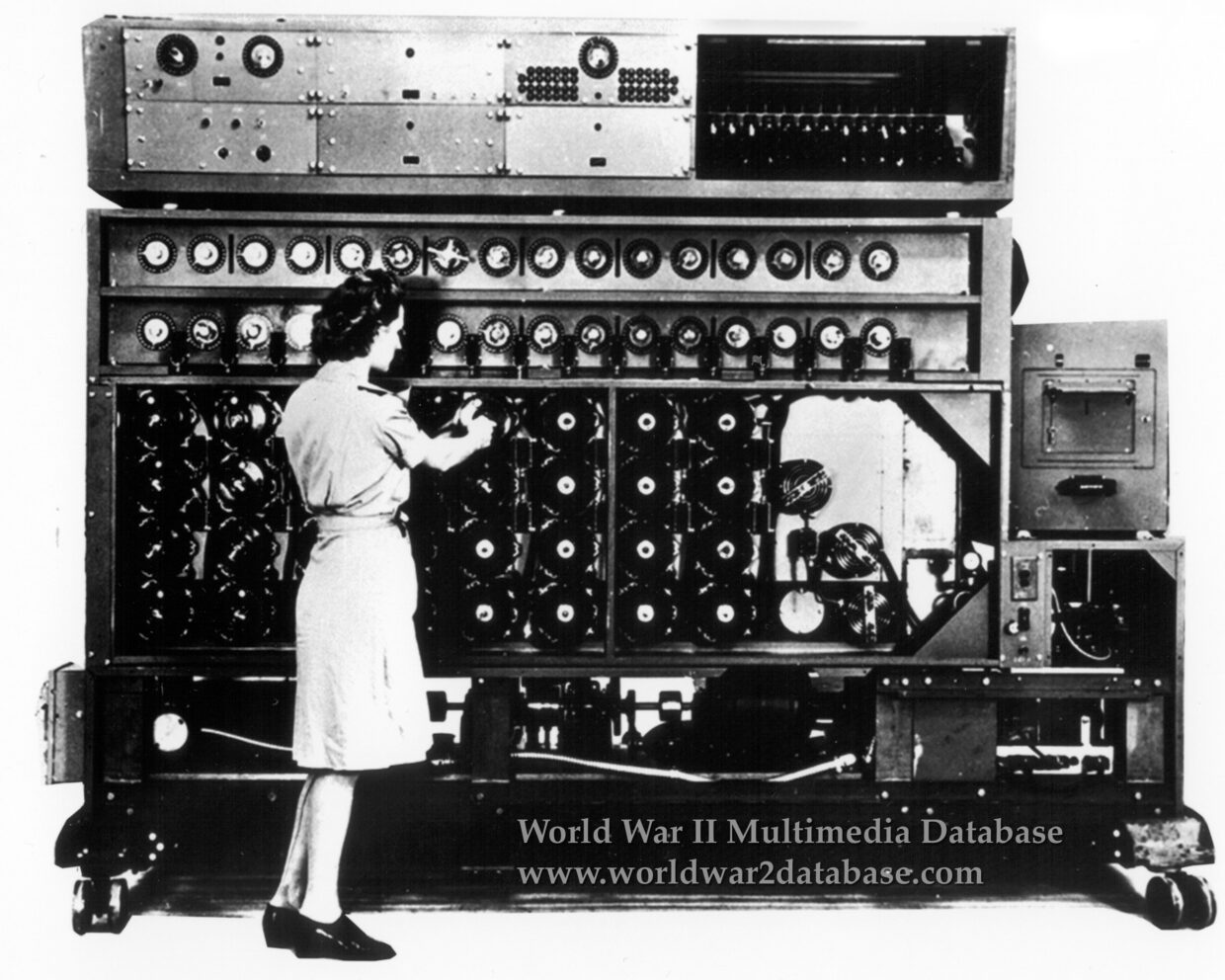| United States Navy “Woman Accepted for Volunteer Emergency Service“ (WAVES) handles a National Cash Register Company (NCR) N-530 Bombe decryption machine for decoding German Kriegsmarine (Navy) naval cyphers encoded with their 4-rotor “Enigma“ machine. She is adjusting the fourth commutator wheel. The British, using advanced codebreaking machines developed by the Poles before that country succumbed to the Nazis in September 1939, developed 3-rotor “Enigma“ machines that could read U-Boat messages until Grossadmiral (Grand Admiral) Karl Doenitz changed the U-Boats to a 4-rotor system in February 1942. The British were unable to build a Bombe to break the 4-rotor “Enigma“ code, even though they had enough intelligence to build it. The United States Navy contracted NCR to build 4-rotor bombes at their factory in Dayton, Ohio, in March 1942. At the time, American losses in the Atlantic were reaching critical levels. The British had promised to supply the United States with 4-rotor Enigma traffic by August 1942, but it was apparent that Bletchley Park, the British Cryptology center, would not be able to meet that deadline. American Naval officers had drawings of the British bombe; working with NCR technician Joseph Desch, realized they could improve the British design. British theorist Alan Turing, who designed the British Bombe, was skeptical. Yet Desch‘s design worked, and the NCR N-530 was ordered into production. The American Navy Bombes stood seven feet high, two feet wide and ten feet long. Each weighed 5,000 pounds. The front and back of the Bombes each had eight columns of four rotors. The top wheel mimicked the Enigma‘s new fourth rotor while the bottom commutator represented the rightmost, or fastest, rotor of the Enigma. The bottom rotor spun at a speed of 1,725 revolutions per minute, which allowed the machine to complete its run in only twenty minutes. Much of the work was done in secret, with WAVEs soldering and wiring the Bombes without knowing what they were building. Elaborate security included round-the-clock tailing of Desch, whose German heritage was investigated. To solder the twenty-six connections for each rotor the WAVES were given twenty-eight colors of wire so that it was difficult for the WAVES to memorize the wiring and report it to German agents. Everyone was threatened with death for talking about their work. Still, with twenty-six connections and twenty-six letters of the alphabet, the WAVES often figured out they were working on cryptology. The bombes were shipped to the Naval Communications Complex on Nebraska Avenue in Washington, District of Columbia. By the end of 1943, 77 Bombes were operational and almost all the Kriegsmarine radio Enigma traffic was being broken by the United States, leaving Bletchley Park to focus on Wehrmacht and Luftwaffe Enigma transmissions. Soon the United States Navy was also breaking that traffic as well. 121 N-530s, and the upgraded N-1530 version, were built through 1944, when the Navy decided further Bombes were not needed. All except one were broken up by hammer and crowbar after the war; the remaining N-1530 Bombe is on display at the National Cryptological Museum in Maryland. Many of the WAVES, sailors and NCR technicians who worked on the project did not know the Bombe had been declassified until they saw the surviving machine on display at the Smithsonian in 1993. | |
| Image Filename | wwii0097.jpg |
| Image Size | 1.84 MB |
| Image Dimensions | 3000 x 2400 |
| Photographer | Unknown |
| Photographer Title | |
| Caption Author | Jason McDonald |
| Date Photographed | January 01, 1944 |
| Location | Naval Communications Annex, Nebraska Avenue |
| City | Washington |
| State or Province | District of Columbia |
| Country | United States |
| Archive | National Security Agency |
| Record Number | Photo 00015 |
| Status | Caption ©2007, ©2024 MFA Productions LLC Image in the Public Domain |

Author of the World War II Multimedia Database

